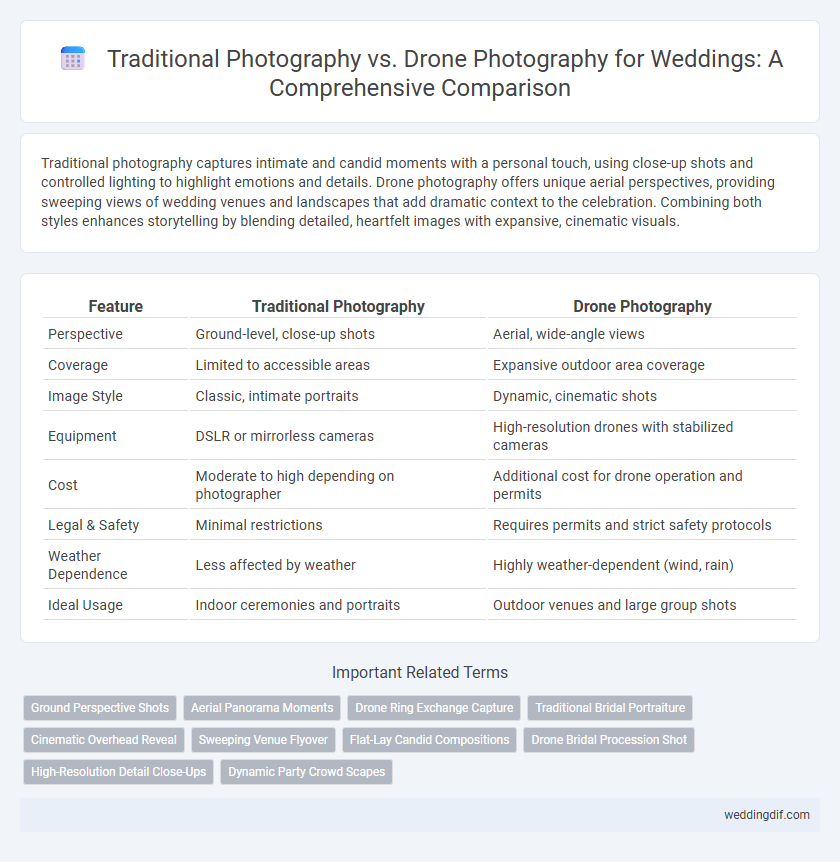Traditional photography captures intimate and candid moments with a personal touch, using close-up shots and controlled lighting to highlight emotions and details. Drone photography offers unique aerial perspectives, providing sweeping views of wedding venues and landscapes that add dramatic context to the celebration. Combining both styles enhances storytelling by blending detailed, heartfelt images with expansive, cinematic visuals.
Table of Comparison
| Feature | Traditional Photography | Drone Photography |
|---|---|---|
| Perspective | Ground-level, close-up shots | Aerial, wide-angle views |
| Coverage | Limited to accessible areas | Expansive outdoor area coverage |
| Image Style | Classic, intimate portraits | Dynamic, cinematic shots |
| Equipment | DSLR or mirrorless cameras | High-resolution drones with stabilized cameras |
| Cost | Moderate to high depending on photographer | Additional cost for drone operation and permits |
| Legal & Safety | Minimal restrictions | Requires permits and strict safety protocols |
| Weather Dependence | Less affected by weather | Highly weather-dependent (wind, rain) |
| Ideal Usage | Indoor ceremonies and portraits | Outdoor venues and large group shots |
Understanding Traditional Wedding Photography
Traditional wedding photography captures intimate moments through carefully composed shots using professional cameras and lighting techniques, emphasizing timeless elegance and emotional storytelling. Photographers often rely on posed portraits and candid shots to document the ceremony, reception, and key interactions between the couple and guests. Mastery of angles, natural light, and classic composition defines the essence of traditional wedding photography, creating lasting memories with a personal touch.
Introduction to Drone Photography in Weddings
Drone photography in weddings transforms traditional wedding photography by capturing breathtaking aerial perspectives and expansive venue views that ground cameras cannot achieve. Equipped with advanced stabilization and high-resolution cameras, drones provide dynamic, cinematic shots that enhance storytelling and offer unique angles of the ceremony, reception, and guests. This innovative approach complements classic photography, adding a modern dimension that elevates the visual documentation of weddings.
Capturing the Ceremony: Ground Shots vs Aerial Views
Traditional photography captures wedding ceremonies through detailed ground shots, emphasizing emotions and intimate moments with close-up angles and natural lighting. Drone photography offers expansive aerial views, providing unique perspectives of the venue layout and large gatherings that ground shots cannot achieve. Combining both techniques enhances storytelling by blending personal expressions with broad spatial context.
Creative Perspectives: Posed Portraits vs Dynamic Angles
Traditional wedding photography emphasizes posed portraits, capturing intimate moments with controlled lighting and carefully framed compositions that highlight expressions and details. Drone photography introduces dynamic angles, offering sweeping aerial views and unique perspectives that reveal the scale and setting of the wedding venue, enhancing the storytelling with cinematic breadth. Combining both methods can create a comprehensive visual narrative, balancing classic elegance with innovative creativity.
Equipment Needs: Cameras vs Drones
Traditional wedding photography relies on DSLR or mirrorless cameras equipped with various lenses to capture detailed portraits and candid moments, requiring tripods, flashes, and other stabilizing gear. Drone photography demands specialized drones with high-resolution cameras, GPS systems, and often remote controllers, focusing on aerial perspectives that standard cameras cannot achieve. Both methods involve specific equipment needs tailored to capturing unique angles and moments, but drones enable dynamic overhead shots while traditional cameras excel in close-up, detailed imagery.
Lighting and Weather Considerations
Traditional photography relies heavily on natural and artificial lighting techniques to capture intimate moments, often requiring controlled environments for optimal results. Drone photography faces unique challenges with lighting due to outdoor conditions and varying weather, necessitating adaptive camera settings to manage glare, shadows, and changing light angles. Weather factors such as wind, rain, and low light can significantly impact drone stability and image clarity, making thorough pre-shoot assessments essential for successful wedding coverage.
Privacy and Legal Regulations
Traditional wedding photography ensures controlled privacy as photographers operate within agreed boundaries and venues, respecting personal space and consent. Drone photography introduces complex legal regulations involving airspace permissions, no-fly zones, and data protection laws to safeguard guests' privacy. Couples must navigate local and federal rules regarding drone use to avoid legal issues and protect wedding attendees' confidentiality.
Budget and Cost Comparison
Traditional wedding photography typically involves hiring a professional photographer with DSLR equipment, costing between $2,000 and $5,000 depending on experience and package details. Drone photography adds an aerial perspective, requiring additional permits and specialized equipment, resulting in an increased budget of approximately $500 to $1,500 on top of standard photography fees. Couples aiming to balance cost with unique visual coverage often consider drone photography as a valuable investment despite the higher budget requirement.
Enhancing the Wedding Album: Mixing Techniques
Combining traditional photography with drone photography elevates wedding albums by offering diverse perspectives, blending intimate close-ups with breathtaking aerial shots. Traditional techniques capture emotional, candid moments, while drone technology adds dynamic visual storytelling through expansive venue views and dramatic overhead angles. Integrating both methods creates a comprehensive narrative that enriches the visual memory of the wedding day.
Choosing the Best Photography Style for Your Wedding
Choosing the best photography style for your wedding depends on your desired aesthetic and coverage. Traditional photography offers classic, intimate portraits and detailed moments captured by skilled photographers, while drone photography provides sweeping aerial views and unique perspectives of outdoor venues. Combining both styles can create a comprehensive visual story, blending personal emotions with expansive scenery for a memorable wedding album.
Traditional Photography vs Drone Photography for weddings Infographic

 weddingdif.com
weddingdif.com